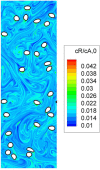The Future of Pharmaceutical Manufacturing Sciences
- PMID: 26280993
- PMCID: PMC4973848
- DOI: 10.1002/jps.24594
The Future of Pharmaceutical Manufacturing Sciences
Abstract
The entire pharmaceutical sector is in an urgent need of both innovative technological solutions and fundamental scientific work, enabling the production of highly engineered drug products. Commercial-scale manufacturing of complex drug delivery systems (DDSs) using the existing technologies is challenging. This review covers important elements of manufacturing sciences, beginning with risk management strategies and design of experiments (DoE) techniques. Experimental techniques should, where possible, be supported by computational approaches. With that regard, state-of-art mechanistic process modeling techniques are described in detail. Implementation of materials science tools paves the way to molecular-based processing of future DDSs. A snapshot of some of the existing tools is presented. Additionally, general engineering principles are discussed covering process measurement and process control solutions. Last part of the review addresses future manufacturing solutions, covering continuous processing and, specifically, hot-melt processing and printing-based technologies. Finally, challenges related to implementing these technologies as a part of future health care systems are discussed.
Keywords: in silico modeling; materials science; mathematical model; process analytical technology (PAT); quality by design (QBD).
© 2015 The Authors. Journal of Pharmaceutical Sciences published by Wiley Periodicals, Inc. and the American Pharmacists Association.
Figures


















Similar articles
-
Control systems engineering in continuous pharmaceutical manufacturing. May 20-21, 2014 Continuous Manufacturing Symposium.J Pharm Sci. 2015 Mar;104(3):832-9. doi: 10.1002/jps.24311. Epub 2014 Dec 26. J Pharm Sci. 2015. PMID: 25546650 Review.
-
Achieving continuous manufacturing: technologies and approaches for synthesis, workup, and isolation of drug substance. May 20-21, 2014 Continuous Manufacturing Symposium.J Pharm Sci. 2015 Mar;104(3):781-91. doi: 10.1002/jps.24252. Epub 2014 Dec 2. J Pharm Sci. 2015. PMID: 25470351 Review.
-
Equipment and analytical companies meeting continuous challenges. May 20-21, 2014 Continuous Manufacturing Symposium.J Pharm Sci. 2015 Mar;104(3):821-31. doi: 10.1002/jps.24282. Epub 2014 Dec 1. J Pharm Sci. 2015. PMID: 25448273 Review.
-
Model predictive control in pharmaceutical continuous manufacturing: A review from a user's perspective.Eur J Pharm Biopharm. 2021 Feb;159:137-142. doi: 10.1016/j.ejpb.2021.01.003. Epub 2021 Jan 9. Eur J Pharm Biopharm. 2021. PMID: 33429008
-
Throughput Optimization of Continuous Biopharmaceutical Manufacturing Facilities.PDA J Pharm Sci Technol. 2017 May-Jun;71(3):189-205. doi: 10.5731/pdajpst.2016.006882. Epub 2016 Dec 14. PDA J Pharm Sci Technol. 2017. PMID: 27974629
Cited by
-
Data-Driven Approach toward Long-Term Equipment Condition Assessment in Sterile Drug Product Manufacturing.ACS Omega. 2022 Oct 10;7(41):36415-36426. doi: 10.1021/acsomega.2c04182. eCollection 2022 Oct 18. ACS Omega. 2022. PMID: 36278076 Free PMC article.
-
In-Line UV-Vis Spectroscopy as a Fast-Working Process Analytical Technology (PAT) during Early Phase Product Development Using Hot Melt Extrusion (HME).Pharmaceutics. 2018 Sep 23;10(4):166. doi: 10.3390/pharmaceutics10040166. Pharmaceutics. 2018. PMID: 30249025 Free PMC article.
-
Hybrid modeling as a QbD/PAT tool in process development: an industrial E. coli case study.Bioprocess Biosyst Eng. 2016 May;39(5):773-84. doi: 10.1007/s00449-016-1557-1. Epub 2016 Feb 15. Bioprocess Biosyst Eng. 2016. PMID: 26879643 Free PMC article.
-
Trend of pharmaceuticals 3D printing in the Middle East and North Africa (MENA) region: An overview, regulatory perspective and future outlook.Saudi Pharm J. 2024 Jun;32(6):102098. doi: 10.1016/j.jsps.2024.102098. Epub 2024 May 10. Saudi Pharm J. 2024. PMID: 38774811 Free PMC article.
-
Recent Development, Applications, and Patents of Artificial Intelligence in Drug Design and Development.Curr Drug Discov Technol. 2025;22(4):e15701638364199. doi: 10.2174/0115701638364199250123062248. Curr Drug Discov Technol. 2025. PMID: 39931986 Review.
References
-
- Yu L. 2008. Pharmaceutical quality by design: Product and process development, understanding, and control. Pharm Res 25(4):781–791. - PubMed
-
- Rathore AS, Winkle H. 2009. Quality by design for biopharmaceuticals. Nat Biotechnol 27(1):26–34. - PubMed
-
- Oksanen CA, Muñoz S García. 2010. Process modeling and control in drug development and manufacturing. Comput Chem Eng 34(7):1007–1008.
-
- Reklaitis GV, Khinast J, Muzzio F. 2010. Pharmaceutical engineering science—New approaches to pharmaceutical development and manufacturing. Chem Eng Sci 65(21):iv–vii.
-
- Callis JB, Illman DL, Kowalski BR. 1987. Process analytical chemistry. Anal Chem 59(9):624A–637A.
Publication types
MeSH terms
LinkOut - more resources
Full Text Sources
Other Literature Sources

